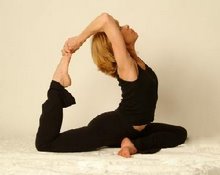The other day a student asked me the following questions:
"Jim, why do you hold the poses for as long as you do? How long should we be holding each pose? What's the rule of thumb?"
I'll answer the latter questions first. The rule of thumb is that you hold the pose to one's capacity. So what does that mean? Well, you don't hold the pose if you're struggling - if your face is clenched, if your breath is rapid, erratic or held, if you're in pain or discomfort, or if you're frustrated or angry. This could mean that you may hardly hold a pose more than a second or two when others in class may be able to hold it for much longer. Some poses are easier to hold for longer durations than others. Tadasana (standing), or Savasana (lying down), can be held for a very long time for most people. Yet other poses, such as Bhakasana (crow pose -balancing on your hands) may be very short in duration. To one's capacity means just that - if you're not capable of doing it, then you don't do it. But then the question becomes - "how does one develop the capacity?" The answer is - over time and with intelligent practice. It takes time and consistent, dedicated practice.
Now to the first question - WHY? Why hold the pose for so long? Some (in fact, most) yoga classes have you moving from pose-to-pose in a flow or vinyasa sequence. Some yoga classes have you really "get a workout" and "break a sweat" as they move from pose to pose. What's the value of holding the pose for so long? The main reason we hold the poses for extended durations is to "sit the mind down" and get it still. Yoga is for the mind as much as it is for the body. In fact, it may have a deeper and more profound impact on the mind than it does on the body. At least that's what the ancient Yoga Sutras say. Scientific research is still looking into this phenomenon. Let me give a few examples of what I'm talking about. Imagine you're in a pose and you're starting to reach your capacity in the pose. What starts to happen? Your mind begins to talk to you. A conversation starts in your head that may sound something like this: "This hurts! I can't do this. I must not be very good at this. Other people look better in the pose. I'm not having as much fun as I did when I was doing the flow yoga class last week." Your mind will say any number of things as you near your capacity. So the challenge is not really the PHYSICAL aspect of the pose so much as it is the MENTAL WALLS and RESTRICTIONS that the mind puts in front of you. What usually happens? The mind wins out, and thus we become slave to the master mind. The mind talks you into its illusion that you can't, that you aren't as good, that it's not as fun. You give up. You stay restricted within the narrow walls of the mind's world. It's a dark hallway of limitations. Over time we experience a daily death of the soul as we never really experience life fully.
All life is an experience. All experience is felt in the body. I believe that if you are able to experience anything in the body (even death - which is truly the only once in a lifetime experience) with a still mind - then you have succeeded in life at the highest human level. This is the promise that yoga offers. To experience all of life's challenges, mysteries, trials, tribulations, joys and sorrows with a still mind. But you have to be willing to wait for it. So that's why we hold the pose - to sit that mind down in it's seat - the seat is the asana.
Peace.
Thursday, January 5, 2012
Subscribe to:
Posts (Atom)


